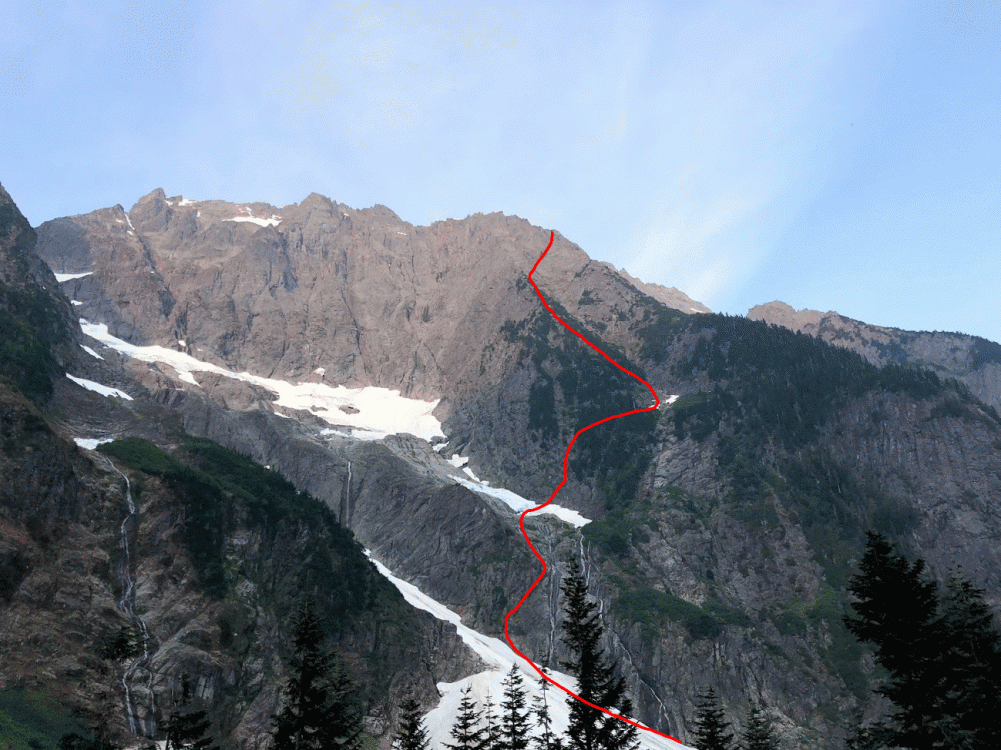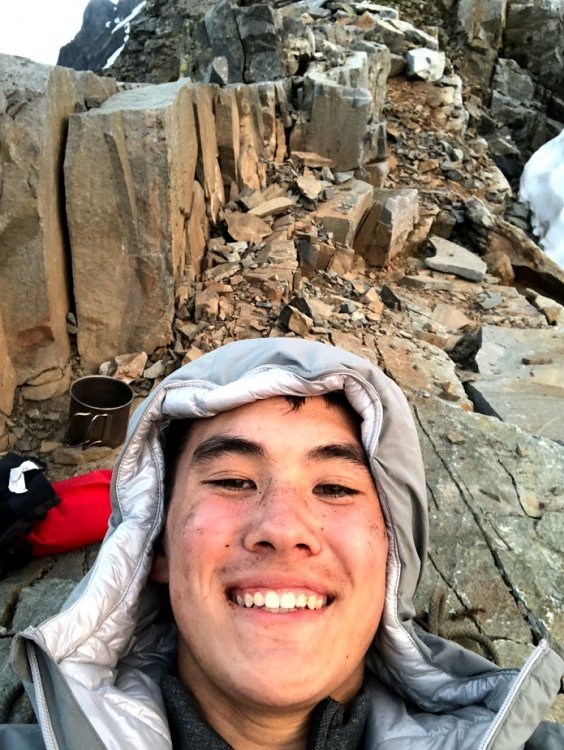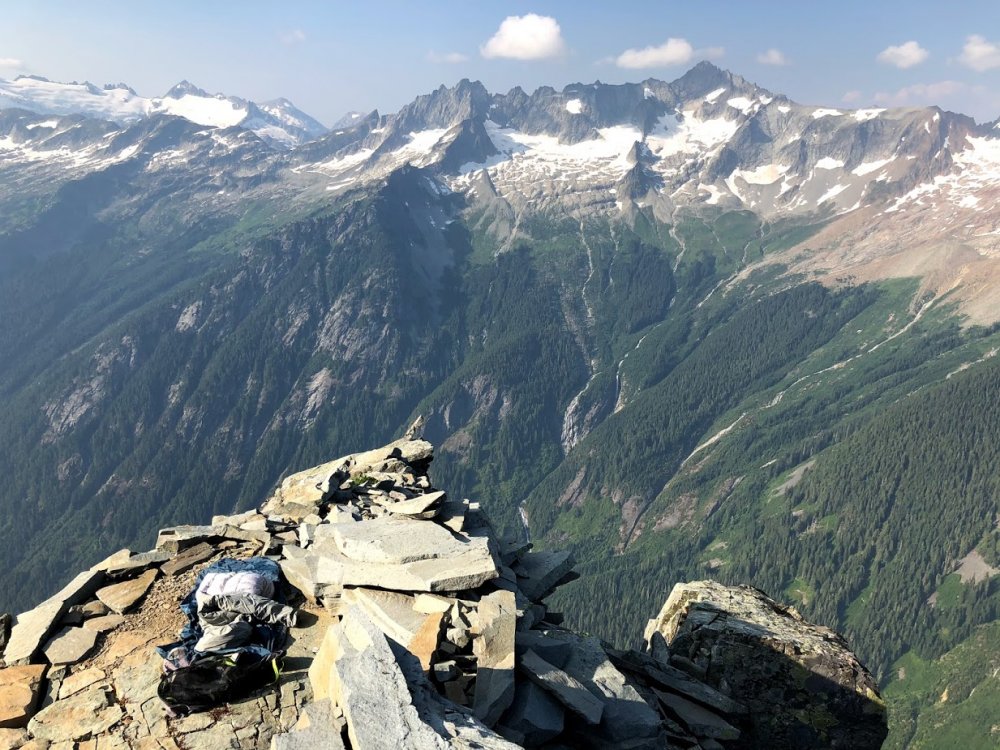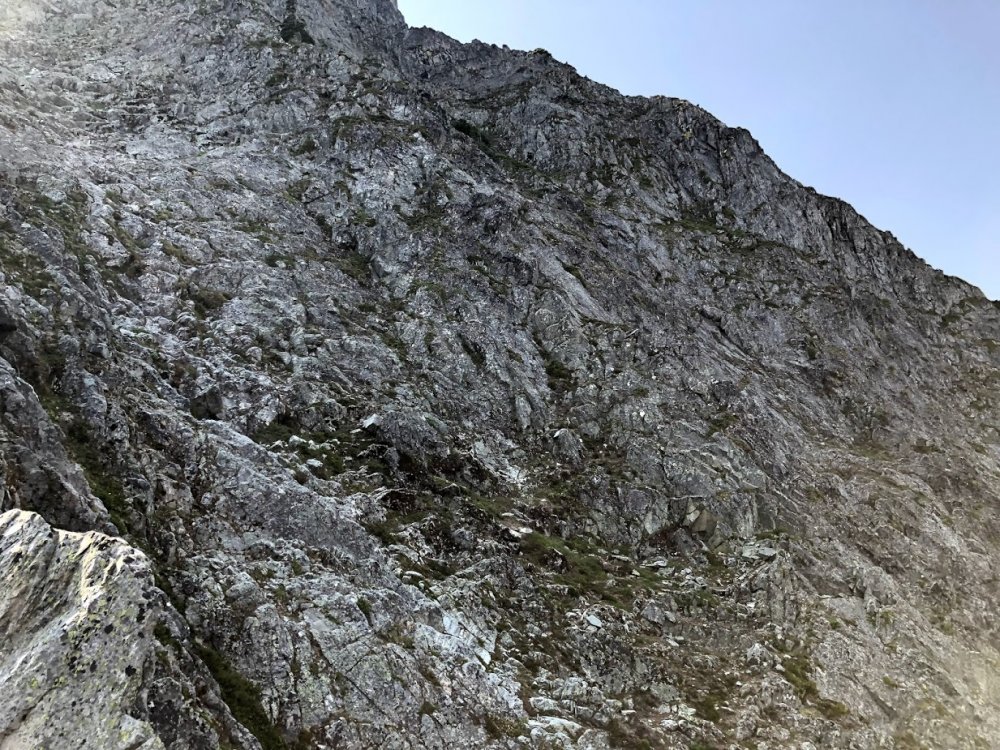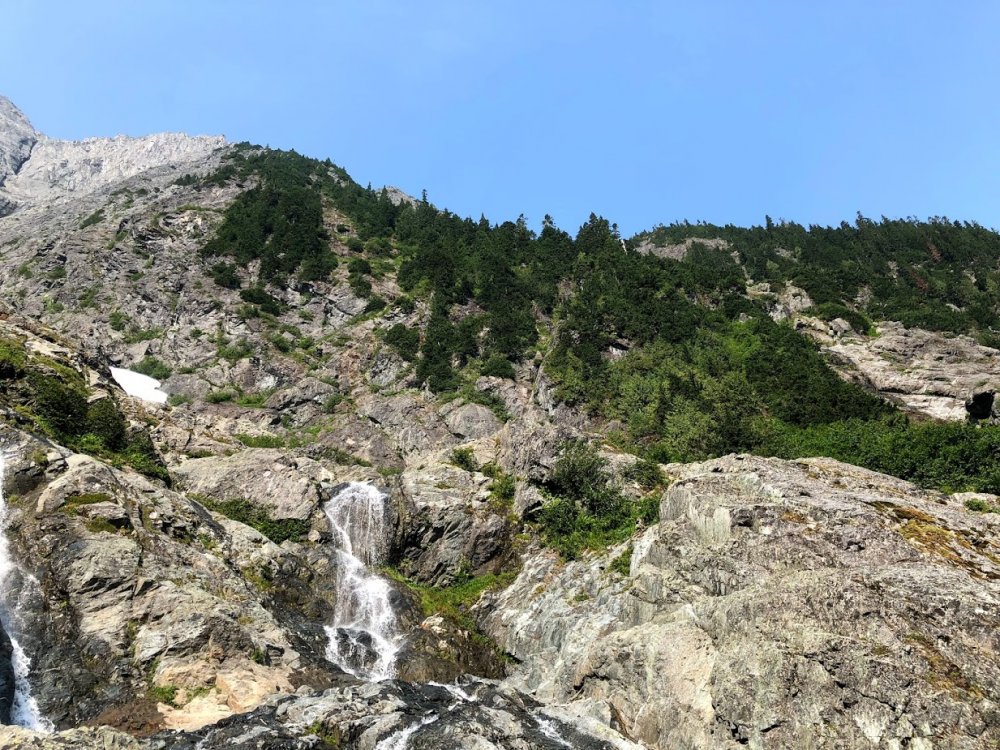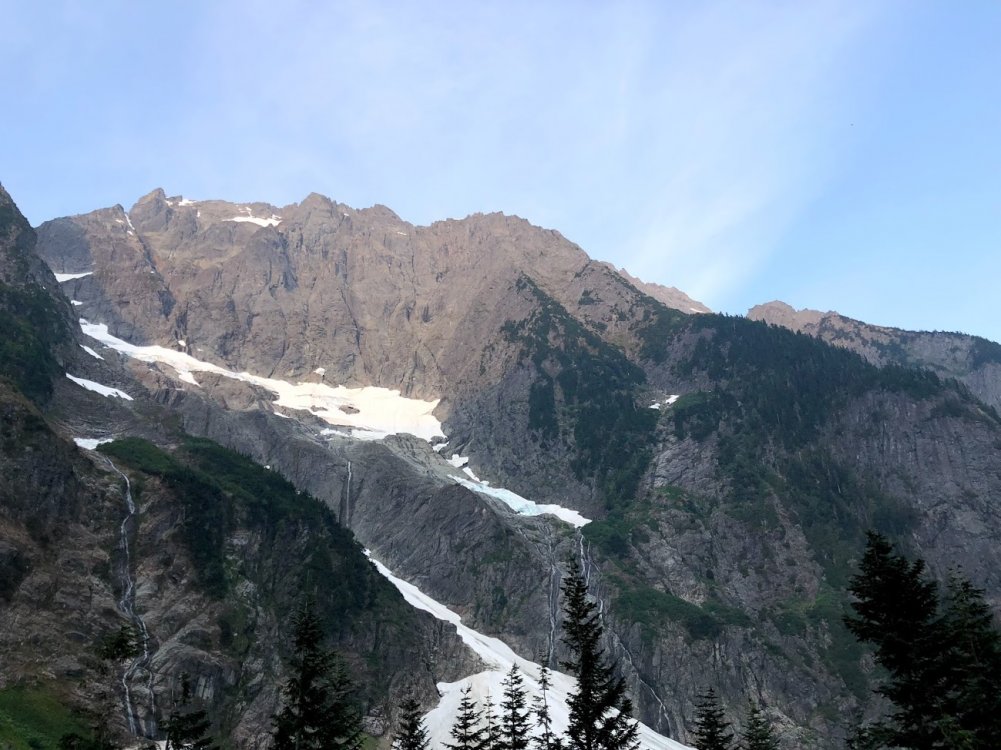Leaderboard
Popular Content
Showing content with the highest reputation on 08/11/18 in all areas
-
Trip: Johannesburg Mountain - NE Buttress Solo Trip Date: 08/01/2018 Trip Report: I overheard some friends talking about Bill Amos' solo of Johannesburg and was immediately inspired. The allure of the mountain and style of climbing was too much to pass up. Before I start my senior year of high school I wanted to do something really fun. After binge reading trip reports and training for a few months, I felt psyched and ready. I already have a decent bit of soloing under my belt so the climb just seemed right. Fast forward to Monday night, I got in my car and drove out to Cascade Pass. I set my alarm for 7:00 but woke up at 6:30 (probably due to the anticipation). The sheer beauty of Johannesburg is impossible to ignore; its imposing face shows so much promise. After scarfing down a breakfast bar and some pop-tarts, I locked my car and began the arduous approach. A grueling .2 miles down the road lead me to a dirt mound with access to the river. Crossing over rocks and walking up a talus field put me at the first snow on the route. The snow was rock hard so my crampons begrudgingly came out of my pack. I was careful to move fast across the snow because I didn't want to get taken out by an avalanche. A rock ramp to the left of the second waterfall provided seemingly easy access to the buttress. Looking up at Johannesburg After some easy slab and low 5th class I arrived at the second snowfield. Here's where I made my first mistake. Once again, the snow was rock solid. I put on my crampons to walk the 100 something feet across it to the rock. Thinking more snow was soon to come, I clipped my crampons to my harness. Looking for a good line through the trees, I decided to go straight up some 4th class rock and then traverse right later on. This beta absolutely sucked. The initial 200 feet or so was smooth sailing. I soon encountered more and more trees, eventually reaching an impassible rock band within the brush. From here I traversed right until I found a gully within the trees that allowed me to climb up. It was hot, steep, and heinous bushwhacking. Finally I could see the third snowfield. At this point I was well above it but had a clear view of the 1957 route. This snowfield basically cuts the buttress in half until they join up again high on the vertical rock. Tired, I took off my pack to eat a probar and drink some water. Looking at my harness I realize only 1 crampon is clipped on. My other must have gotten eaten by trees earlier in the bushwhack! Thinking about Jean-Christophe's rescue on Annapurna reminded me that I'm probably not going to die if I'm short one crampon. Slabs before second snowfield. It's hard to describe how much the trees suck. I found no evidence of a path and basically pulled on branches, heather, and devil's club the whole way up. Things would frequently get caught on my rope or ice tools during this section. Another hour or so of this put me at the heather slopes. For about 800 feet I walked up some easy 3rd class slopes covered in heather. The 70 degree heat made me really thirsty. I brought 2 liters of water and realized it probably wasn't going to last all the way to the bivy. Rationing out water was uncomfortable but that's life. More scrambling finally put me on the rock. What a relief! Soon 4th class rock turned into low 5th and life was peachy. It felt absolutely euphoric to move well on the steep slopes. I didn't find loose rock to be that big of an issue. I checked my watch and realized I was about 400 feet from the bivy. Up ahead of me looked to be the "crux" rock section. I traversed right from the 1951 route on to the approximate 1957 route. I think this allowed me to skip some hard sections because I encountered maybe 5.6 rock up to this point. Though the glacier was still obscured by rock, I knew I was close. Rock face. I stayed in the middleish left My fatigue meant I wasn't climbing at my best. I elected to take off my pack for the next 200 feet or so and just haul it up. Some 5.8 face climbing through loose rocks put me on top of a small ridge. I was at the glacier! After bringing up my pack, I scrambled up some 4th class rock and was at the bivy. I drank straight from the glacial runoff. This was the first time in my life I was happy to see mosquitoes. The struggles of the day melted when confronted with the beauty of the mountains around me. After a warm meal and some relaxing. I was sound asleep in my bivy sack. Bivy of the decade Me stoked to be fed and hydrated Waking up at 6:30 was kind of cold. I didn't bring a sleeping bag but was pretty was comfy nonetheless. After some packing and eating, it was time to get on the glacier. This part was less than ideal. The snow was luckily much softer than at the base of the mountain. Despite only having one crampon, climbing up the snow to the arete was easy. After carefully walking on the arete I decided going straight up the headwall would be hard. I downclimbed a few meters to the rock ridge. The rock actually went! Easy scrambling and some short traverses on the snow allowed me to skip almost all of the glacier and headwall. At the summit ridge I scrambled up right to the biggest peak. I made it! It turns out I was the first person there in almost a year! The log could also use some more paper if anyone is going up there soon. The feeling of being up there is indescribable. Signing the summit log and snapping a few photos, I was ready to head down. Headwall. I scrambled on the rock to the left Obligatory summit selfie Signing the climber's log Staying to the south side of the gendarmes, follow a loosely marked carin path to the East face. I opted to rap instead of downclimb initially. 8 bomber rappels brought me to some low angle heather. It's important to aim straight for the CJ col. There looks like other paths would be better but they cliff out. About 600 feet of downclimbing brought me to the col in one piece. Looking up from the col Now sidehilling ensued. Going close under the buttress and heading straight toward Doug's Direct seemed to work best. Walking through all the brush isn't fun but the ascent to mix up peak was easy. About 1000 feet 3rd and 4th class scrambling down the north ridge of Mix Up brought me to Cache Glacier. The climbers trail is visible from the top of the ridge; go there. Walking down the climbers trail felt like one of those flat escalators at an airport compared to the rest of the climb. 3.7 miles of running and I was back to the parking lot. Looking down from the top of Doug's Direct. This was a climb to remember. The beauty of the North Cascades is hard to forget. I don't think I'll be back to Johannesburg for at least a few more months. I would really love to try and get up it in the winter. Shoutout to Steph Abegg and everyone else who has previously made trip reports. I have mad respect for anyone who has done this climb. Don't let your guard down when you get to the summit. Johannesburg is the mountain that keeps on giving. Now its time to get ready for Bear Mountain. Here's the general route I took. I could have screwed up but I'm pretty sure this is where I went. Gear Notes: Took climbing shoes and chalk but didn't need them. Approach Notes: Walk .2 miles down the road. Cross river.1 point
-
Trip: Pickets - North Buttress of Fury (during Pickets Traverse) Trip Date: 08/04/2018 Trip Report: Lani Chapko and I were planning on climbing Mount Robson via either the Kain Face or North Face, but weather looked iffy so I came up with a new objective that I thought would be equally challenging. We totally sandbagged ourselves on this route. Neither of us looked to closely at beta or trip reports, we just knew that the buttress was often approached from glaciers on the west side and the rock was supposed to be 5.6 or easier. I figured it would be like the DNB of Stuart with a long approach but no 5.9 climbing... The initial plan was to do a full Pickets traverse from Hannegan to Newhalem, climb Challenger, Fury, and maybe a Southern Picket. We set up the hella long car shuttle and started hiking to Hannegan Pass on Thursday afternoon. I screwed up big time and crossed the Chilliwack at the wrong point, and we traverse for an hour through steep trees to finally arrive at the faint trail up to Easy Ridge. ^ Getting lost on the way up to Easy Ridge As the sun set we set up camp at Easy Ridge and hoped for a dry night despite a wet forecast. On Friday we traversed over to Challenger in low visibility conditions. The Imperfect Impasse was snow-free, making things quite a bit more challenging than when I crossed it in May. On the way back up out of the Impasse, we hauled packs for a section. ^ Crossing the impasse We then crossed the Challenger glacier, also without any visibility. Lani was a route-finding pro somehow, and we didn't dead-end on any crevasses. Arriving at Challenger arm, the clouds cleared and we got our first look at our route up Fury *insert swallowing and stomach knots here*. ^Our route up Fury. Keep reading to know what NOT to do. We set up camp in Luna Basin and talked a bit about life and death (mostly death), and whether or not we should draw a line somewhere with regards to alpine climbing. We woke up at 4:30am and started up the west side of the buttress. ^The North Buttress in early morning The first crack at the base of the buttress we avoided by going to the right on mid-5th, loose, unprotectable rock. We soloed up without packs and then hauled them up with our rope. This became a common theme on the "approach", the glacier-carved rock was largely devoid of cracks and it seemed futile to use a rope without gear. The next rock band was harder and longer, we mostly went straight up from the top of the first snowfield and I found just one gear placement in about 130 ft of climbing. I think going further left and clipping trees would have been a better option. From here we excitedly got back on the steep snow and headed up toward the rock chute of doom. ^ rock chute of doom There was a big 'schund that extended out to the rock chute of doom (RCOD) forcing us to quickly cross the chute and head up the snow to the right. Throughout the approach so far we had noticed a couple small rocks coming down the chute but nothing worrisome. We climbed the snowfield and crossed the RCOD at a big boulder back onto the left snowfield/glacier. At this point it started raining lots rocks and ice, both down the chute and to the left and right of it, we quickly got under a big boulder at the base of the next rockband. We climbed the next rockband via the left side of the large boulder we sheltered under to avoid being in the shooting gallery. We looked down with distressed as more rocks and ice rained down on our approach path, meaning bailing would be a dangerous proposition as temperatures rose. Finally we scrambled up toward the buttress crest and excitedly put on rock shoes. We encountered a difficult 5.8ish step almost right away, which was not very well protected. We wanted to simulclimb a lot of the ridge, but with only a few cams and some nuts it was hard to climb for a long enough time to make simuling efficient. So we ended up doing a mixture of long pitches and soloing/scrambling. ^ Lani after pulling a 5.9ish roof and finding a hand crack, one of very few sections of good climbing on the route. We climbed up rock for a while before arriving at the "snow crossing". We were able to skirt the snow on the right side, however, and avoid putting shoes/crampons on. ^ "Is it hands?!?" - Me ^ "It's friggin hands Tyler!!" - Lani More scrambling intermixed with 5th class led us up toward the snow arete. We noticed the skies were getting dark to the east after a remarkably clear day. After finishing a long pitch, I looked up at the rest of the route. At that moment, electricity rained down from the sky. The thunder and lightning occured simultaneously and sounded like a bomb, striking the mountain a stone's throw away. I looked down at Lani, "On belay?". We continued climbing to find a better spot to hunker down. By the time the storm looked like it was subsiding, it was about 7pm and we weren't sure if we would be able to top out in daylight. We found an almost tent-sized area with just a few thousand feet of exposure off the eastern edge of the buttress. After moving rocks to make a vaguely flat platform, we decided we would take up landscaping afterward and setup the first light as the rain started to fall. ^ Setting up camp in a rather precarious position I slept comfortably despite having my feet over the edge, and we woke at first light with a plan I was not excited about. It was Sunday morning. Our car was in Newhalem and I was supposed to be at work on Monday morning. We had a bit of extra food but not enough to continue through the Southern Pickets. I told Lani we'd take the "fast" way out via Access Creek to Ross Dam. She didn't know what that meant luckily. We climbed up the half snow-arete, half choss ridge. ^ On the second section of snow near the top of Fury ^ The final section of climbing to the summit area/false peak. I felt pretty maxed out in my approach shoes on this gradient Topped out at about 7:30am. All we had to do was traverse steep heather/talus/snow to Luna Col, then up and back down to Access Creek, shwack out the creek to the trail, and then hike 17 miles out to the highway, and then hitchhike back to Newhalem to pickup Car #1, drive back to Hannegan to pickup Car #2, and then back home. Our splits roughly: 4:15am - Wake-up from thunder bivy camp 7:30am - Topped out on Fury, called boss to tell him I may not be at work on Monday 1:30pm - Arrived at start of gully down to Access Creek 6:30pm - Arrived at Big beaver trail, made dinner 12:00am - Arrived at Ross Lake, made breakfast 4:00am - Arrived at HWY 20 6:00am - Got hitchhike to Newhalem 9:00am - Arrived at Hannegan trailhead 11:00am - Ate huge pizza in Glacier, WA 2:00pm - Crashed on a beach in Seattle, WA We weren't moving particularly fast, but we kept moving! The Pickets are rough but soo addicting, I'm headed back this weekend Gear Notes: 60m rope, a few cams, nuts, 1 axe each, crampons Approach Notes: In via Hannegan, out via Ross Lake Dam (not planned)1 point
-
Best climbing film I've seen in a while. You might want to wear a diaper while watching the sequence starting around 28:00. Lama is the real deal and it seems like he's maturing well while still pushing the limits.1 point
-
1 point
-
Nice work dude! Looks like you've been getting some good mileage up there this summer.1 point
-
Trip: The Himmelhorn - South Face-"Stonehenge" (FA) Date: 7/6/2015 Trip Report: The Himmelhorn, South Face First Ascent (“Stonehenge”) Jason Schilling and Tim Halder. 7/6/15. 5.10, 8 pitches 1400’ “We were born too late. Roper’s already been here. We’re just picking up his scraps.” Tim mused as we gazed up at the unclimbed South Face of the Himmelhorn. Maybe so, but he nor anyone else had ventured onto the big face in front of us. We wondered if there was a reason for its neglect as we tried to agree on a safe but proud line while lounging amongst the wildflowers of the Crescent Creek basin. I’d like to think that I’ve paid my dues in the Pickets. I spent three nights stormbound on the summit of Mt. Fury in 2008 with Donn Venema and Steph Abegg. Donn and I wore parallel sleeping grooves into the ice during that first bout of Picket's purgatory and I’d often wake up with his legs draped over mine or with his hot breath on the back of my neck. Fortunately we got along well. He invited me into the range for three extended trips in two years and became an alpine mentor and great friend to me. Donn and I sampling the bourbon at Perfect Pass during happier times (photo by Steph Abegg) The next year I was back with Donn and Steph and new partner Steve Trent. The trip came to a crashing halt when Steve was injured badly in a fall on the North Buttress of Mt. Terror. I stayed behind to care for Steve and help with his helicopter rescue and ended up spending four dark days in a coffin-sized crack waiting for another storm to clear. Although it took a while for me to recover phsychologically from that episode, I eventually emerged with a renewed passion for the mountains and climbing and a profound reverence for partnerships that make the alpine experience so worthwhile for me. That event changed my life in many ways. It exposed me to a wider circle of climbers and brought several people into my life that have since become dear friends. Tim was one of them. Tim and I were supposed to go the Sawtooths this summer to climb some of the classics and fish in the alpine lakes. A gentleman’s trip of alpine leisure. But when I asked him if he was interested in a week of route exploration in the Southern Pickets, he succinctly responded “yes sir!” Tim likes to sell himself short as a mediocre rock climber, but he has several things going for him which make him an exceptional partner on remote and unknown alpine trips. He’s an elite endurance athlete with an incredible motor. He’s also an elite joker. His accents on one pitch can range from Russian to British to Indian. But most importantly, he’s a gamer. Put him at the crag, and he’s bored and disinterested. Put him on an unclimbed face in the cascades or the Himalaya, and he steps up to the plate, big time. He’s an alpha choss-dog who’s quite capable of pulling a difficult technical move at 20,000 feet with an overnight pack on. A perfect partner for the Pickets. We shouldered monster packs on July 3rd and headed up through what Tim describes as a “medley of suffering” from the jungle of Goodell creek to a bivy at the breezy and scenic col below the Chopping Block overlooking the Crescent Creek basin and its namesake spires. Snow was scarce in the basin approaching the col and the water situation later this summer could be grim for that spot, unless the snowfield on the slopes above persists. We had our eye on the easternmost tower of the Rake as a warm up. Wayne Wallace informed me of it a few years back in the Index parking lot, mentioning that it was unclimbed as far as he knew. It looked short enough and reasonably solid. We were wasted from the approach and needed a short introductory objective to get acclimated with the Pickets. The Turret, right of center, above the Terror/Rake col After a leisurely morning at the col, we moved camp into the Crescent Creek basin amidst a collection of large boulders scattered about the heather. We were perfectly situated next to a stream with intimate views of the Crescent Creek Spires. Some snow persisted in the gully leading up to the Terror/Rake col, but soon we were directly beneath the tower, scouting our options. The rock directly above the col appeared compact and difficult, so Tim led off slightly left on loose ground. I followed with an exciting and airy pitch on improving rock. Tim took over on the final pitch as we simul-climbed easy 5th class terrain to the summit. We saw no evidence of an ascent and figured we may be the first to climb the tower. John Roper has since informed us that he had climbed it back in 1984, naming it the Turret. We were indeed picking up his scraps. Nevertheless this was a good introduction to what lay ahead. We spent the next day lounging and recovering at camp and took a leisurely stroll through wildflower meadows to scope the south face of the Himmelhorn. The South Face of the Himmelhorn, center We even had time to sew It probably sees an ascent every other year or so, by either the standard route put up by Ed Cooper, George Whitmore, Glen Denny, and Joan and Joe Firey in 1961, or the highly regarded Wild Hair Crack climbed by John Roper, Silas Wild, and Russ Kroeker in 1981. The face looked complex, but had several options. We considered the far left line that would lead past an interesting and steep dihedral before mellowing out on a long traverse of the summit ridge and its various pinnacles. The direct line looked most interesting to us, finishing on the summit tower and I was thrilled when Tim suggested it. Our plan was set for the following morning. Having nearly melted off of the first ascent of Golden Horn’s East Face the week prior with Joe Sambataro, I wanted to avoid another flirtation with heat stroke. We left our camp at four the next morning under clear skies and some of the warmest pre-dawn temps I’d ever experienced in the pickets. We were on the snow at 5 and started up easy ramps and ledges. The climbing was straightforward and fun and took us to a grassy col where we finally pulled out the rope and rack. Jason picking a line low on the South Face. Above us lay a feature we called the shield. It was three pitches of impressively solid rock. Tim led out on blocky, intermediate terrain for the first pitch and I followed with an attempt on an incredible looking dihedral. Tim start out on blocky ground on the first pitch of Stonehenge, the South Face of the Himmelhorn. I had to clean the lower part of the crack to reveal perfect hand jams but soon dead-ended at an unprotectable and flaring wide crack. I traversed left onto solid face climbing followed by a brief lieback and great hand jams. The rock went from solid to excellent as we moved higher. Jason encounters varied and solid climbing on the second pitch of ‘Stonehenge’ on the South Face of the Himmelhorn. “Tim’s Flake” on the fourth pitch Tim works past the incredible flake on the 4th pitch as the summit tower looms above Soon we were at the base of the summit tower and I lobbied for going straight up it to the summit. Surely we could find something that would go and take us to the top in 2 pitches or less. The rock was compact and steep. I had a cruxy traverse with poor feet but good protection down low and then the protection vanished. I aimed for a salvation crack 40 feet above my last possible piece of protection. The climbing was exhilarating. Pushing my fears aside, I moved past the runout difficulties to steep and joyous cracks and a belay 2/3 of the way to the top of the tower. Jason leads up the steep and runout 6th pitch. We were confronted with steep rock and sparse protection above, so Tim opted for a wild traverse on solid but unprotectable pock-marks to a notch between the summit tower and a pinnacle. Following the airy traverse of the 6th pitch The difficulties were over! He let out a whoop after reaching the notch and brought me over to his scenic belay overlooking the Mustard Glacier and wild McMillan Cirque. From there it was one cruiser pitch to the summit on low 5th class on deteriorating rock. It’s funny how so many of these N. Cascades peaks turn to rubble right at the top. I spied an old Kodak film register whose vintage seemed to be way before my time. We were amazed to find the original summit log from 1961 in the canister as well as the Roper and company’s chronicle of the Wild Hair Crack. The original summit register from 1961 We lounged on the summit for an hour, reveling in the views and the warmth, overjoyed with the climbing that was now behind us. I was overwhelmed with gratitude for this moment and the shared creative experience with Tim felt like a gift. The rest of the trip was all downhill, more or less. We spent our last night at the Chopping Block bivy, partying with the meager libations at hand, and watching Spinal Tap’s “Stonehenge,” in honor of our new route’s name. I could finally relax with the satisfaction of successfully returning to the range where I had learned and suffered so much. And it was reassuring to know that Roper had left a few blank canvases untouched and that more await for those who are willing to put in the effort. Summit or Siberia! (somehow my rotated photos reverted to their orignial state once they were uploaded to this server) Gear Notes: Double ropes, Double-cams from .4 to 3 Approach Notes: Goodell Creek to end of road, cross Terror Creek, then up up up like little hobbits to the Chopping Block ridge bivy.1 point



